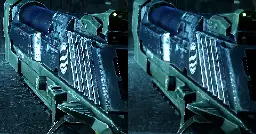That ATX board would be great. The mATX B650M PG is also better than the previous one, it is good enough. If you can find the B650M-HDV/M.2 in stock that is even better if you don't need 3 m.2 slots.
That monitor was indeed a lucky deal. It looks to be a good combination for this setup.
I don't think it's the scheduler this time with a single CCD, but there is significant difference. These tests focus on compute and productivity with almost no games, so most of the difference could come from this bias. Another possible option is the power profile (EPP balance_performance) holding back the 7700x on linux.
The draft is pretty good. Only a few points to consider changing:
- That is an entry level Motherboard which may limit your upgrades in the future. It overheats with a 16 core ryzen 9.
- The ram size is good, but the speed and latencies are just as important nowadays. A 6000 MT/s CL30 Expo ram could improve CPU performance, but it's a kind of OC so not every combination is fully stable at the highest speeds.
- Especially with competitive and indie games it's easy to run them at high FPS. I would consider getting a 1440p high refresh rate (144+ Hz) monitor if you don't have one already. It's a huge upgrade coming from 1080p60Hz.
That's a very old video format, which is definitely not HDR.
Some GPUs support the MPEG4 codec maybe try updating the driver. Did you try turning on or off Hardware acceleration for the transcodig?
Navigate to a problematic movie or episode -> 3 dots -> Get info -> right column -> Color space
Usually SDR is bt709 and HDR is bt2020. In older codecs (h264) 10 or 12 bit color depth can also cause issues.
I'm not sure how tone mapping works on plex since I don't have a pass but with Jellyfin you need to setup OpenCL which is run on the GPU so your guess that a hardware change can break it is plausible.
green tinge to them
Are you sure it's corrupted and not an unsupported HDR color format?
Corrupted files usually skip frames or get blocking and ghosting errors.
As an Android flavour it should be safe after uninstalling all apps associated with the university. Did any of them need a "device owner" permission? That's the only way to be more persistent on Android without root access.

YouTube Video
Click to view this content.
What's Being Done?
13:30 - the systems deployed for both companies with either one of these processors to within one percentage Point are experiencing the same stability issues even disabling ecores has not fully resolved the issue for one of these companies the error rate also seems to be going up over time on the server side
The mobile and TV clients are often limited to the codecs with hardware acceleration. Or just selecting a lower bitrate on the client will cause transcoding.
The FS feature is great, it's just cumbersome to use without a tool.
Snapper works well for a local backup like history both against botched updates and accidental deletion, but eats up the free space with the default settings.
Timeshift is an easy to use GUI but doesn't support non-default partitions.
Also the quota support had a nasty side effect: freezing the whole system on snapshot deletion.
It's hard to live up to expectations after Frieren but here are some that were memorable for me:
- Fate Zero - it's a battle royal with magic, the story isn't the focus but the characters and fights are great
- Spice and Wolf - this is about a merchant's journey with an unusual companion (there is a new (re)adaptation coming next season, but the old version is also quite good)
- A Certain Scientific Railgun - a sci-fi city and it's secrets, I think it does well in the would building
I think calling it a "cache" is not precise. The primary function of the DRAM is to hold the dictionary for translating logical addresses (e.g. sectors) from the OS to the physical addresses (which NAND chip, which bank etc.). This indirection is needed for the controller to do wear leveling without corrupting the filesystem.
On a SATA SSD without DRAM each read IO could mean 2 actual reads: first the dictionary to find the data and than the actual data being read. As you said HBM helps by eliminating this extra read.
The read and write caching is just a use of the remaining DRAM capacity. Since modern Operating Systems use the general RAM for the same function it is usually just a small increase to the throughput.
if the integrated one is good enough for gaming
No, the iGPU is only meant for testing and basic desktop usage like video playback on the 7000 series. There are 8000G series with better integrated graphics but even those are much weaker than any dedicated GPU.
Could you tell us more specifically what do you want to use/play on this PC? (e.g browsing or productivity apps, or old games or the latest AAA titles)
A maximum budget would be very helpful.
If you are looking to reduce the build's cost consider a cheaper motherboard or a used GPU. The Asrock B650M-HDV/M.2 is the lowest you should go if it has all the connectors you need. As for buying used video card it's always a bit of risk, but as the most expensive component you could save the most on that. Since all AM5 CPUs have an integrated GPU you could build without the dedicated GPU first.
Video version: https://youtu.be/0PrmrMQ9gJU
In February 2024, Intel held its first Intel Foundry Direct Connect event. [...] The tone of the event was one of success – Intel Foundry (IF) is set to be a semi-autonomous body of Intel that aggressively fights for business, whether Internal or External, without playing favorites.
[...]
Ian: It’s been said in the past that Intel bets the whole company on the next process node, is that still true?
Pat: I’ve bet the whole company on 18A. We have committed products to this - it is the culmination of our 5 nodes in 4 years. So bringing that across the line, in that sense yes - I’ve bet the whole company on making this successful.
Maybe you could use a USB keyboard or mouse connected trough a dock or OTG converter to allow file transfers.
TAA is a crucial tool for developers - but it's not without its issues. Digital Foundry reports.

cross-posted from: https://lemmy.world/post/11840660
> TAA is a crucial tool for developers - but is the impact to image quality too great? > > For good or bad, temporal anti-aliasing - or TAA - has become a defining element of image quality in today's games, but is it a blessing, a curse, or both? Whichever way you slice it, it's here to stay, so what is it, why do so many games use it and what's with all the blur? At one point, TAA did not exist at all, so what methods of anti-aliasing were used and why aren't they used any more?
TAA is a crucial tool for developers - but it's not without its issues. Digital Foundry reports.

TAA is a crucial tool for developers - but is the impact to image quality too great?
For good or bad, temporal anti-aliasing - or TAA - has become a defining element of image quality in today's games, but is it a blessing, a curse, or both? Whichever way you slice it, it's here to stay, so what is it, why do so many games use it and what's with all the blur? At one point, TAA did not exist at all, so what methods of anti-aliasing were used and why aren't they used any more?
Here are some initial benchmarks of the Grace CPU performance while the Hopper GPU benchmarks will be coming in a follow-up article.
NVIDIA's GH200 combines the 72-core Grace CPU with H100 Tensor Core GPU and support for up to 480GB of LPDDR5 memory and 96GB of HBM3 or 144GB of HBM3e memory. The Grace CPU employs Arm Neoverse-V2 cores with 1MB of L2 cache per core and 117MB of L3 cache.
On a geo mean basis across all the benchmarks conducted, the GH200 Grace CPU performance nearly matched the Intel Xeon Platinum 8592+ Emerald Rapids processor. The Arm Neoverse-V2 based Grace CPU tended to be much faster than the 128-core Ampere Altra Max AArch64 server.
Overall the NVIDIA GH200 CPU benchmarking was quite fascinating to see its early potential. There still are some workloads not too well optimized for AArch64 and in some cases the higher core counts and dual socket configurations available with Intel Xeon Emerald Rapids and AMD EPYC Genoa(X) / Bergamo could drive the results much higher.
There is an even more relevant video of using external storage trough USB. He recommends using software raid:
Are both drives fully encrypted with LUKS? Is trim enabled in both crypttab and fstab?
Thanks for the links! I updated my config from z3fold to zsmalloc and adjusted the vm.page-cluster to test these out.
Reading a bit more, I think when using large max_pool_percent (>30) with Zswap the two solutions are more similar than not. A crucial difference is what use-case is more acceptable since Zswap can cause unresponsiveness (and potential lockup) under high memory pressure. While Zram could result in an OOM crash in a similar worst-case scenario.
While today we have both the AMD EPYC “Genoa-X” and “Bergamo” launches, Bergamo is clearly the more impactful of the two. That is a lot to say given we know that Microsoft Azure is very fond of Milan-X and Genoa-X. Let us put together a few key points:
- The primary change for Zen 4c cores from Zen 4 is a halving of L3 cache.
- The AMD EPYC 9754 is showing performance ~3x a 128-core Arm competitor at 1.5x the power.
- An AMD EPYC 9754 is often twice the performance of 2019’s AMD EPYC 7002 “Rome” 64-core parts.
- On most non-HPC-focused workloads, expect the AMD EPYC 9754 to be 15-20% faster than the AMD EPYC 9654. That is not a straight 33% as we would expect due to the core count increase, but AMD is getting scaling from the increased core count even with a drastically reduced L3 cache size.
- AMD seems to have figured out an elegant way to reduce turbo clock jitter, especially at maximum load. That helps a lot with SLA on a loaded system.
- Cloud-native processors will make up a huge segment of the market.
We have a video for this one that you can find: https://www.youtube.com/watch?v=BxLBLEeq6yg

YouTube Video
Click to view this content.
This tour of AMD's Austin Headquarters features labs from around the sprawling campus, allowing us a never-before-seen look at the tools used by a hundred-billion dollar chip designer. During these tours, we get to see unreleased prototypes - like vapor chamber heatspreaders, first-party direct die plates, and unnamed CPUs - while also learning about the technology and tools used to test and design AMD's Ryzen (Zen) processors. The tour goes through the Bring-Up Lab, the codename "red door" lab, a thermal engineering lab, the device failure analysis lab, and an IHS etching facility.

